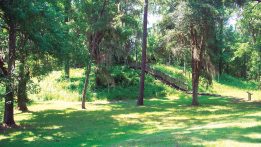Types:
There are two types of blueberries common in North Florida: the Rabbiteye and Southern Highbush. Within these types, there are also several varieties. Rabbiteye varieties are known to be somewhat easier to grow, but Southern Highbush varieties produce good fruit as well. Bushes of Rabbiteye varieties are larger than Southern Highbush varieties, sometimes twice the size and also produce larger fruit which ripens in June and July. Along with being smaller and producing smaller fruit, Southern Highbush varieties ripen earlier than Rabbiteye varieties.
Planting:
Blueberry bushes are best planted mid-December through mid-February, but they can be planted anytime. For the best fruit output, plant a few different varieties together to aid pollination. They need to be planted in a location with acidic soil because of the amount of organic matter they need. Mulch, such as peat moss and pine bark, can help improve soil with a low amount of organic matter. Their location needs to spend around five hours in direct sunlight and needs to receive an adequate level of water drainage as well. If water sits within eighteen inches of the surface of the soil for an extended amount of time, root damage can occur. For areas with poor water drainage, a raised bed is recommended. Although your blueberries will need some fertilizer later on, do not put fertilizer in the planting hole.
Care:
- Watering: Watering your blueberry bushes is most important during the first year of growth because they cannot be drought-tolerant until they develop their branched root systems. During the first spring and summer, slowly pour at least one gallon of water onto the root ball every two days. As the plants mature, they become fairly drought-tolerant, requiring watering less often. Mature plants should only need one to two inches of water a week as the fruit grows; only more than one-fourth inch of rain counts toward watering.
- Fertilization: Blueberries do not respond well to over-fertilization; therefore, start small and gradually increase the amount of fertilizer as needed. Use an acidifying fertilizer like one used for azaleas and camellias. For the first year, spread one ounce (or one and a half ounces for mulched soil) of fertilizer in a two foot circle in April, June, August, and October. Increase one ounce and one foot in diameter each year until the circle is eight feet in diameter.
- Pruning: Once planted, strip or prune the flower buds to direct the plant’s energy to root development rather than fruit growth. Continue to do this for the first two years for a strong root system. For plants with larger root systems than flower growth at the time of planting, pruning at the time of planting will be less severe. Pruning requirements also decrease as your blueberry plants mature. For the first few years, little pruning is necessary; you should only need to remove small twig-like growths. After four years, prune the oldest canes (the vertical branches stemming from the roots), cutting back about one fourth of them each year. Pruning helps stimulate future growth; however, pruned canes will likely not produce fruit the following harvest.
Harvest:
Ripe blueberries are a deep, dark blue and should fall off the branches easily. Once you have grown your own blueberries, you can experiment with different recipes or simply enjoy your fresh blueberries on their own. You can use them to make blueberry pancakes, muffins, scones, cobbler, and much more. For a patriotic twist, try using them to top a red velvet cake or with strawberries and whipped cream. ![]()
By Kimberly McMahon






